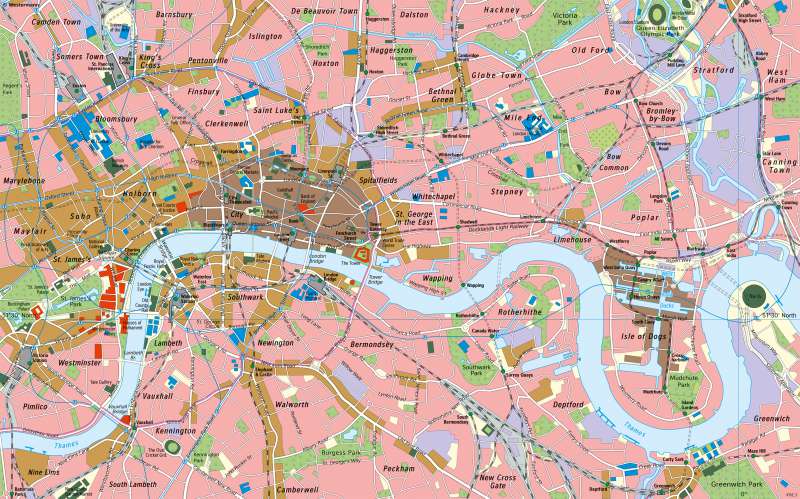Central London and Docklands - Urban land use
Urban development
978-3-14-100890-6 | Page 86 | Ill. 2

Overview
The map shows the functional division of "Central London" and the western parts of the Docklands on the Thames. The Roman settlement, the historical core of the metropolis, was almost identical in area to the "City of London", which, despite its rather small size, is one of the most important economic and financial centres in the world.
Districts and quarters of London
Between the City and the political centre of Great Britain, the "City of Westminster", there are residential and office districts with a mixture of functions, interspersed with shopping streets. In addition to the royal palaces in the St. James's district, there are numerous ministries, the Parliament building (Westminster) and, especially in Mayfair, various embassies. In addition, there are a large number of theatres in nearby Soho and many hotels and restaurants in Marylebone. A significant part of the area of Central London is taken up by parks, which often house historic representative buildings.
While the traditional residential quarters of the upper classes are located near the inner-city green spaces and upstream on the north bank of the Thames, the areas south of the Thames and in the east of the city used to be dominated by working-class neighbourhoods. With exorbitant property prices several times higher than the national average in the British capital, the once poorer districts have been severely affected by gentrification, displacing low-income households.
For decades, central London was extremely congested by car traffic. In 2003, a congestion charge zone was established, which was extended to Westminster, Kensington and Chelsea in 2007. As of 2017, the London charge zone is still one of the largest congestion charge zones in the world, despite the removal of the Western Extension which operated between February 2007 and January 2011. Today, driving through the area is only permitted for a daily fee of 15 pounds (approx. 17.25 euros). As a result, car traffic has decreased considerably in favour of public transport; bicycles are also being used more again.
Nowhere in London has the change of function in recent decades been as drastic as in the Docklands, the harbour district to the east of the Tower. The outdated docks were closed down between 1967 and 1981 because of increasing competition from new port locations. Tens of thousands of workers lost their jobs and the Docklands developed into an inner-city problem area.
From 1981, the infrastructure was modernised and partially rebuilt. Parts of the Isle of Dogs were declared an "Enterprise Zone", where companies - mainly from the light industry, wholesale and service sectors - were given special planning and tax preferences. Residential areas of great architectural diversity were also created, mostly those in the upper price range in the immediate vicinity of the shore. Old warehouses were given new uses by being converted into offices or luxury flats, and water-related leisure facilities settled in various locations. The architectural flagship of the revitalisation is the Canary Wharf high-rise complex on the west side of the Isle of Dogs, which changed London's skyline. The Docklands were made accessible by the Docklands Light Railway, which runs on stilts. While the Isle of Dogs initially served as an expansion area for city uses, it has since become a rival location for the City of London due to the concentration of high-level financial services.
With the abandonment of the commercial waterfront and waterfront areas in Docklands, old commercial sites above the Tower have also become available for office, retail or residential uses. At the same time, an ensemble of cultural institutions has been established south of the Thames since the 1970s with the Tate Gallery at Vauxhall Bridge, the London Eye in front of the Old County Hall, the Royal Festival Hall, the National Theatre, the Globe Theatre and the Tate Modern.




